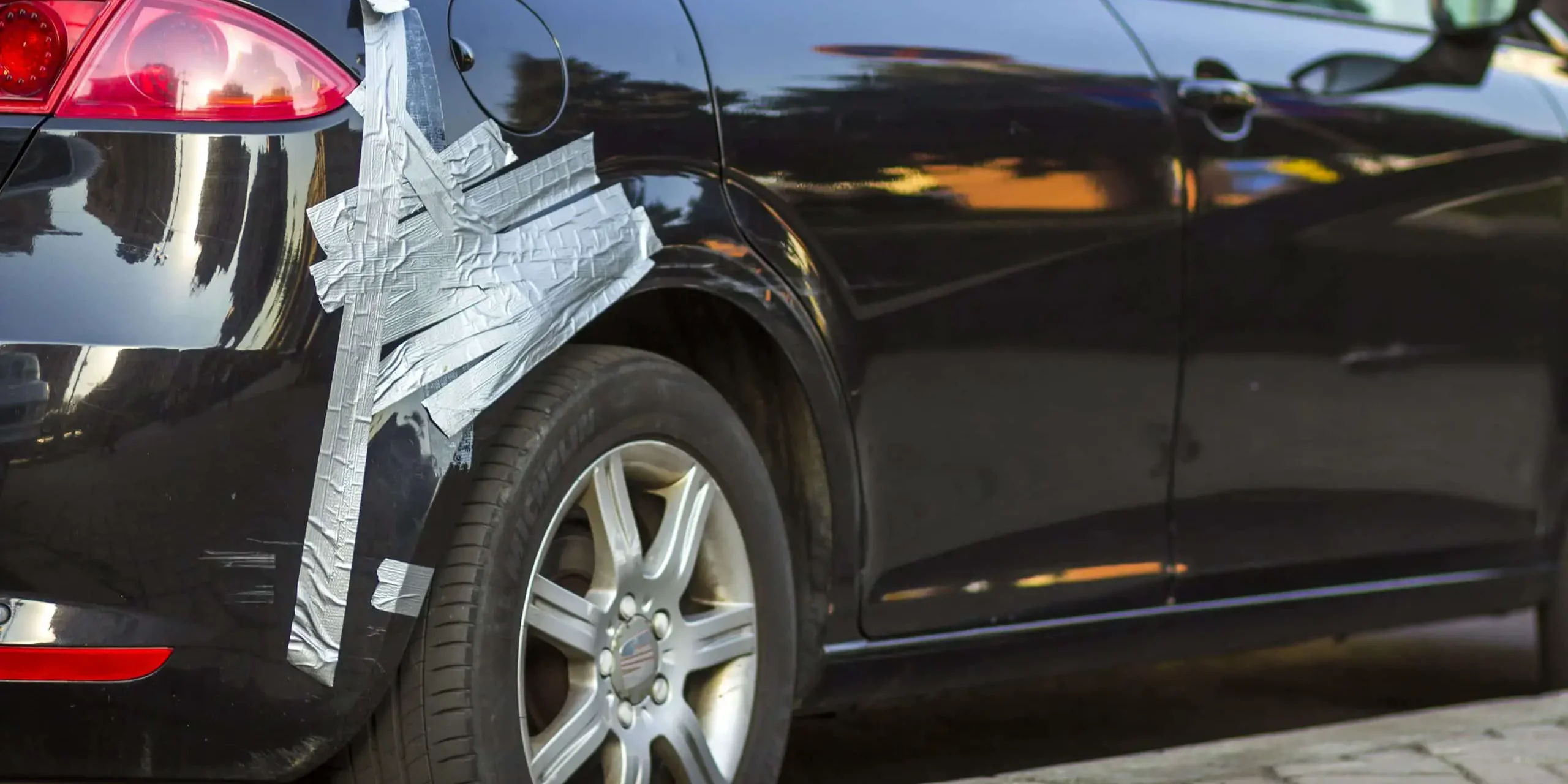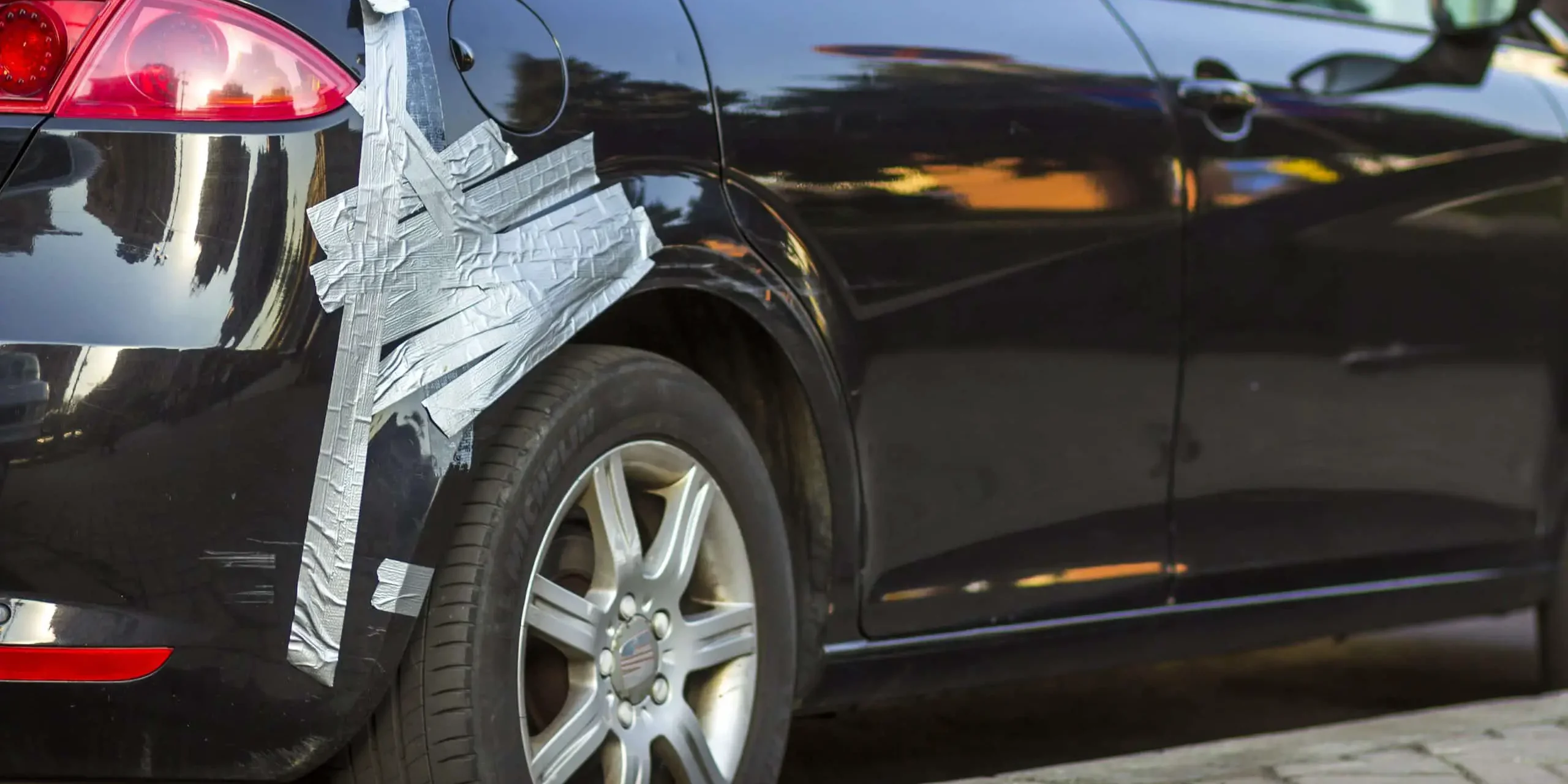how to get duct tape residue off car


How to Remove Duct Tape Residue from Car Paint
Removing Duct Tape Residue from Car Paint requires careful handling as the sticky residue can damage the car’s paint surface. Here is a step-by-step guide to help you with this task:
- Use a hairdryer or heat gun to warm up the duct tape residue. The warmth will loosen the adhesive, making it easier to remove.
- Apply a small amount of Goo Gone, rubbing alcohol or WD-40 onto a clean microfiber towel. Rub the residue gently in circular motions until it loosens and starts to come off.
- If there are still stubborn bits left, apply more solvent and let it sit for a few minutes before gently rubbing again.
- Rinse the area with soapy water and dry it with another clean microfiber cloth.
- Finally, apply car wax or polish onto the cleaned spot to ensure that the area remains shiny, smooth and protected from any further damages.
It’s important not to use harsh solvents or abrasives as they can scrape away paintwork which may lead to costly repairs later on.
Moreover, keeping your car clean and regularly maintained decreases its susceptibility to sticky adhesive substances sticking on paintwork. With these tips, you will have no trouble removing duct tape residue safely from your vehicle’s surface.
According to Consumer Reports, using certain chemicals such as lighter fluid can further damage your car’s paintwork while trying to remove duct tape residues hence should be avoided entirely.
Time to raid the pantry for some unlikely heroes in the sticky situation of removing duct tape residue from your car.
Using Household Items to Remove Duct Tape Residue
Using Natural Household Solutions to Eliminate Sticky Residue Left by Duct Tape
Have you ever struggled with finding the perfect solution to getting rid of duct tape residue from your car? Fret no more, as you can use natural household items to remove it effectively.
Here’s a simple 3-step guide for using natural household items to remove duct tape residue:
- Begin by dampening a cloth in warm water and rubbing it over the sticky residue. This will soften the glue.
- Add a few drops of dish soap to the cloth and rub it over the area until the sticky residue is removed completely.
- Finally, rinse the area with water and dry it off with a clean cloth.
Apart from this, it’s essential to ensure that you do not use sharp objects to remove the residue as it may damage the paint of your car.
Pro Tip: Instead of a cloth, you can also use a sponge to remove the duct tape residue. Use a solution of hot water with vinegar to soak the sponge for an easier removal process.
In summary, using natural household solutions is an effective way to remove duct tape residue from your car without causing damage to its paint. By following these simple steps, you’ll be able to remove the sticky residue easily. If rubbing alcohol doesn’t work, at least you can drown your sorrows in it while you contemplate your car’s sticky situation.
Rubbing Alcohol
Household items such as a common antiseptic named isopropyl alcohol, can be used to remove duct tape residue. Due to its solvent properties, rubbing alcohol helps break down the sticky material and makes it easier to clean the surface.
First, take a cloth or cotton ball and pour some rubbing alcohol on it. Then, rub the cloth on the affected area until all the residue is gone. Be careful not to scrub too hard and damage the surface.
It’s essential to use only 70% or higher concentration of rubbing alcohol as lower concentrations aren’t as effective.
Additionally, applying rubbing alcohol may also help sterilize the area by eliminating harmful bacteria present due to unclean adhesive residue. It provides an easy solution for cleaning surfaces stained with stubborn duct tape residue without causing any harm or damage.
Using household items can be quite beneficial when dealing with unexpected situations like removing unpleasant duct tape residues from surfaces of objects. However, it’s important to carefully choose which item to use based on things like composition, safety profile, and efficacy.
Whether it’s removing duct tape strips from floors or excess adhesive left behind from sticking posters onto walls, taking prompt action and using items available at home could save you time and money that would have been spent on store-bought solutions.
Who knew vinegar could do more than just make your fries taste better?
Vinegar Solution
Combating Residue with Vinegar
Frustrated by duct tape residue that just won’t budge? Consider using a vinegar solution.
- Combine equal parts white vinegar and water in a spray bottle.
- Saturate the area affected by the residue.
- Let it sit for several minutes, allowing the acidity to break down the adhesive.
- Use a scraper or clean cloth to gently remove the residue, being careful not to damage any surfaces.
- Rinse thoroughly with warm water and dry completely.
- Repeat if necessary until all traces of the adhesive are gone.
Don’t have white vinegar on hand? Try apple cider vinegar as a substitute. Its high acid content can break down tough adhesive remnants without resorting to harsh chemicals.
Looking for additional tips on removing stubborn stains from household items? Check out our other practical solutions.
Don’t let pesky duct tape residues hold you back. Try this natural and cost-effective remedy today. Your clean surfaces will thank you!
Who knew baking soda could be so versatile? It’s not just for baking cookies and cleaning teeth, but now it’s also a duct tape residue remover!
Baking Soda Paste
To remove duct tape residue, a useful household item is a mixture of baking soda and water. This concoction creates a paste that can be applied to the affected area.
- Combine baking soda and water until it forms a paste.
- Saturate the area with the paste.
- Let it sit for 10 to 15 minutes.
- Scrub the affected area with a soft-bristled brush.
- Rinse off the residue with warm water.
Using this method is an easy and quick solution to rid duct tape residue from surfaces. For thicker adhesives, applying more baking soda may be necessary.
This tip dates back to the early 1900s when baking soda was first used as a cleaning agent. Its versatility made it an ideal solution for cleaning and removing tough stains like duct tape residue.
Who needs a genie in a bottle when you have WD-40 to grant all your adhesive-removing wishes?
WD-40
This particular household item has long been known for its versatility in removing stubborn substances such as adhesives, grease, and grime. Its brand name may not be uttered due to its strong odor that can lead to health concerns if inhaled excessively. Nevertheless, it is an effective solution for getting rid of duct tape residue. Just remember to use it sparingly and wipe off any excess with a clean cloth.
Some other options for removing duct tape residue include using rubbing alcohol, vinegar, or baking soda mixed with oil. Each method requires different steps and precautions, so choose the one that suits your needs best. For example, rubbing alcohol evaporates quickly so make sure to work fast and avoid prolonged exposure to your skin.
When using household items to remove duct tape residue, always test first on a small and inconspicuous part of the surface before proceeding with the main task.
According to The Spruce.
Why waste money on expensive adhesive removers when you can just use peanut butter to get rid of duct tape residue? Just don’t let your dog catch wind of it.
Peanut Butter
Using a household item for removing duct tape residue has its own unique charm. One such item that has gained a lot of popularity is the creamy spread made from peanuts. It is commonly known as ‘PB‘.
- PB consistency and texture is perfect for gentle scrubbing on surfaces, without causing any damage.
- It contains oil, which helps break down the adhesive, thus making it easier to remove residue.
- The natural oils in PB leave behind a refreshing smell, unlike other chemical removers, which can be toxic and unpleasant-smelling.
- PB is economical, easily available, and non-toxic compared to many expensive solvents or removers.
If PB is not ideal due to allergic reasons or unavailability, other plant-based nut butter spreads like almond butter or sunflower seed butter can likewise work as an effective alternative.
Pro Tip: Make sure you don’t use too much of the spread over the affected area; otherwise, it might get messy while cleaning up the sticky goo.
If household items fail, resort to the chemical warfare of commercial products to vanquish stubborn duct tape residue.
Using Commercial Products to Remove Duct Tape Residue
Using Effective Products to Remove Duct Tape Residue
Removing duct tape residue requires a delicate touch, especially when dealing with a car’s surface. The use of the right commercial products can make it a lot easier to get rid of this stubborn residue. This article will show you how to get it done quickly and easily.
Step-by-Step Guide
- Choose the right product: Start by choosing the right product for the job. Look for adhesive residue removers that are specifically designed to remove duct tape residue. Some of the popular options include WD-40, Goo Gone, and Bug and Tar Remover.
- Apply the product: Apply the product directly to the affected area. Be sure to follow the manufacturer’s instructions, and let it sit for the recommended amount of time. Avoid using too much of the product, and ensure that it does not come into contact with non-affected areas.
- Wipe the residue away: Use a soft cloth or microfiber towel to wipe the residue away. You may need to apply some elbow grease to remove the more stubborn residue. Avoid using abrasive materials that may scratch your car’s surface.
Additional Information
Remember to test the product in an inconspicuous area before applying it to the affected area. This is to ensure that it does not react negatively with your car’s surface.
True Story
Emily had left duct tape on her car’s side mirror after fixing it. She tried removing the residue with household items like baking soda, vinegar, and even nail polish remover, but they didn’t work. She then decided to use a commercial adhesive remover designed for cars, and it worked like a charm!
Say goodbye to sticky situations with Goo Gone – it’s like a superhero for your car’s duct tape residue.
Goo Gone
Goo Gone is a commercial cleaning solution specifically designed to remove adhesive and other stubborn residue from various surfaces. Its powerful formula includes citrus extracts that allow for easy removal of sticky substances like duct tape, stickers, and gum. Goo Gone is safe to use on most surfaces, including glass, plastic, and painted surfaces. It also does not leave an oily residue after cleaning.
Furthermore, a little bit of Goo Gone goes a long way in removing residue, making it a cost-effective choice for households, offices or industrial settings. It’s interesting to note that Goo Gone has been in the market since 1981 and has earned the trust of many people as a reliable solution for tough-to-remove residues.
Say goodbye to your duct tape residue problems with 3M adhesive remover, just like how duct tape says goodbye to hostages’ mouths in the movies.
3M Adhesive Remover
This particular commercial product is formulated to remove any adhesive residue left on surfaces. It is widely known as the 3M Adhesive Remover. The solution consists of potent and effective ingredients that can eliminate even tough adhesives with ease.
Using 3M Adhesive Remover is quite simple. First, apply the solution onto the affected area and allow it to sit for a few minutes. After some time, scrub gently with a soft cloth or brush until all residue has been removed.
One thing worth mentioning about this product is that it’s entirely safe for use on most surfaces. Therefore, it should pose no threat to your furniture or equipment if used appropriately.
If you’re looking to tackle particularly old or stubborn residues, try using multiple applications before scrubbing or using a more powerful product like Goo Gone.
Overall, when faced with duct tape residue, one of the most effective solutions available in the market today is the 3M Adhesive Remover. It’s safe to use on almost any surface and delivers excellent results quickly and easily.
You might not be able to get rid of your ex’s clingy tendencies, but Turtle Wax Bug and Tar Remover can definitely remove duct tape residue.
Turtle Wax Bug and Tar Remover
This commercial product is a solution to remove the remnants of pesky bug and tar buildup on your car. It is efficient in eliminating adhesive-backed leftovers from duct tape residues that get stuck on various surfaces like glass, metals, and plastic.
- Turtle Wax Bug and Tar Remover delivers accomplished performance in removing stubborn spots that can harmfully affect your car’s appearance.
- The product effortlessly dissolves tar, bug residue, tree sap, grease, asphalt smudges, brake dust, and more without affecting the surface structure or causing any rusting or discoloration.
- This chemical-free formula consists of a strong solvent blend that makes it ideal for vinyl surfaces such as dashboards and side panels.
- Turtle Wax Bug and Tar Remover comes packed in a convenient spray bottle that makes application effortless while minimizing waste and mess.
Apart from its comprehensive features mentioned earlier, customers find this product very useful due to its affordable price point compared to other similar alternatives. Many satisfied users have even reported remarkable results with this product on their outdoor furniture removal tests. Turtle Wax Bug and Tar Remover has thus become one of the most sought-after solutions for removing unwanted substances from surfaces for both automotive and household applications.
Don’t worry, taking precautions when removing duct tape residue is a sticky situation that doesn’t have to leave you in a bind.
Precautions to Take when Removing Duct Tape Residue
Paragraph 1:
Removing Duct Tape Residue can be a tricky process, but with the right precautions, it can be done effectively.
Paragraph 2:
- Evaluate the surface: check for vulnerable layers and test in small areas.
- Gather the tools: gloves, goggles, plastic scraper, microfiber cloth, and cleaning agent.
- Protect surrounding areas: cover adjacent surfaces with cloth or paper.
- Apply cleaning agent: Spray on the adhesive residue and let it soak in for a few minutes.
- Scrape the residue: Use the plastic scraper and remove slowly and gently.
- Clean the surface: Wash the area with water and dry with a microfiber cloth.
Paragraph 3:
It is essential to remember not to use any sharp or metal scraper, it can scratch the surface. Using a heat gun or a hairdryer can soften the residue and make it easier to remove. Additionally, avoid leaving the cleaning agent on the surface for too long, it can damage the paint.
Paragraph 4:
Pro Tip: Always read the labels of the cleaning agent before using them to avoid damage to the surface.
Before you go full-on Breaking Bad and start scrubbing away at your car with duct tape residue, test the solution on a small area first – trust me, your car will thank you.
Testing the Solution on a Small Area First
One way to ensure the safe removal of duct tape residue is by testing the solution on a small, inconspicuous area first. This will prevent any potential damage to the surface and ensure that the solution works effectively.
To test the solution on a small area first:
- Choose a small, inconspicuous area on the surface where the duct tape was applied.
- Apply a small amount of regular rubbing alcohol or an adhesive remover to a cloth or cotton ball.
- Gently rub the solution onto the selected area.
- Wait for a few minutes for any adverse reactions such as discoloration or damage to occur.
- If there are no negative effects, proceed with removing the duct tape residue from the entire surface using the tested solution.
It is essential to note that certain fabrics and surfaces may not react well with certain solutions. Therefore, it is necessary to take precautions and test on smaller areas first before commencing with larger sections.
Interestingly, according to Consumer Reports, WD-40 can also be used as an alternative adhesive remover for minor residue instances.
Don’t worry, the gentle pressure and soft cloth won’t hurt the duct tape residue’s feelings.
Using Gentle Pressure and Soft Cloth or Sponge
To gently remove duct tape residue, it is recommended to use a soft cloth or sponge with light pressure. This technique will prevent damaging the surface and leaving any further marks.
- Start by wetting the soft cloth or sponge with warm soapy water and wring out any excess water.
- Gently rub the affected area with the damp cloth or sponge in circular motions, applying only slight pressure.
- Rinse the area with clean water to remove any remaining residue or soap.
- Dry the surface with a clean towel or allow it to air dry completely.
Additional care should be taken if the surface is fragile or has a protective coating. It’s also essential to avoid using abrasive materials such as scouring pads, which can scratch and leave permanent damage.
Source: According to an article published on www.familyhandyman.com
Skip the fancy manicure and opt for protective gloves, unless you want to spend the next week peeling off duct tape residue instead of your nail polish.
Wearing Protective Gloves
Protecting Hands from Harm during Duct Tape Residue Removal
When it comes to removing duct tape residue, protective gloves are imperative. They not only safeguard your skin but also reduce the risk of transferring chemicals present on residue to other objects.
- Choose heavy-duty gloves that can withstand solvents and adhesive agents found in duct tape.
- The gloves should fit snuggly over your hands to prevent chemicals from seeping through any gaps.
- Place a few layers of cloth or paper towel beneath the residue while wearing the gloves to avoid contact with hazardous substances.
It is important to remember that wearing protective gloves may not eliminate all potential risks associated with duct tape residue removal. Consider other precautionary measures such as proper ventilation and using suitable tools.
In a DIY project, Jane was removing duct tape residue from her car’s surface without wearing any gloves. The residue contained harsh chemicals that had passed through her skin, making her ill for weeks. She learned her lesson the hard way and promised never to put herself at risk again by taking safety precautions seriously.
After removing duct tape residue, don’t forget to rinse and dry the area – unless you want your friends to think you’re growing a new skin.
Rinsing and Drying the Area After Removal
After removing duct tape residue, it is essential to cleanse the area thoroughly to avoid any irritation or discomfort. This requires “Cleaning and Drying the Surface after Removal.” Here’s how you can do it in four easy steps:
- Take a dry cloth and gently wipe away any loose residue from the surface.
- Soak another cloth in warm, soapy water and use it to gently clean the area.
- Rinse with clean water and dry with a towel or allow it to air dry completely.
- For stubborn residue, soak a cloth in rubbing alcohol and scrub the area until clean.
Remember not to scrub too hard, as this could damage surfaces.
In addition, using hot or cold water instead of warm can make soap scum stickier, making cleaning more challenging. It is also important to avoid touching the area right after cleaning to prevent further irritation.
Pro Tip: Before using any solution on delicate surfaces, always test it on an inconspicuous spot first.
Say goodbye to duct tape residue and hello to a car that won’t stick out like a sore thumb…unless you’re really bad at parking.
Conclusion – Enjoying a Residue-Free Car
Getting rid of duct tape residue from your car can be a daunting task. However, it is not impossible and can indeed be achieved with the right approach. By following some simple steps, you can enjoy having a residue-free car once again.
- First, gather some basic tools such as rubbing alcohol or vinegar, a clean cloth, and a plastic scraper.
- Apply the rubbing alcohol or vinegar to the residue and let it sit for a few minutes.
- Wipe the residue away using the clean cloth or use the scraper to gently remove it if needed.
- If the residue is particularly stubborn, try using a commercial adhesive remover that is gentle on car surfaces. Always test any product on an inconspicuous area first before applying it all over.
- Remember to work in small areas at a time and rinse with water after applying any cleaning product to avoid damaging the car’s paintwork.
Pro Tip: To prevent future damage, avoid using duct tape on your car altogether by investing in removable tapes or magnets designed for automotive use instead.
Frequently Asked Questions
Q: How can I remove duct tape residue from my car’s surface without damaging the paint?
A: One of the best ways to remove duct tape residue from your car is to use a mixture of warm water and soap. Apply the solution to the affected area and let it sit for a few minutes before gently scrubbing it away with a soft cloth.
Q: Can vinegar be used to remove duct tape residue from a car’s surface?
A: Yes, vinegar can be an effective solution to remove duct tape residue from your car. Mix equal parts of vinegar and warm water, apply it to the affected area with a soft cloth and let it sit for a few minutes. Wipe the area with a wet cloth to remove the solution residue.
Q: Is WD-40 safe to use on my car’s surface to remove duct tape residue?
A: Yes, WD-40 can be used to remove duct tape residue, but it should be used sparingly and washed off with soap and water to avoid any damage to the car’s paint.
Q: Can baking soda be used to remove duct tape residue from my car?
A: Yes, you can use baking soda and water to create a paste that can be applied to the affected area. Let it sit for a few minutes before wiping it off with a soft cloth.
Q: What’s the best way to remove duct tape residue from plastic car parts?
A: The best solution for removing duct tape residue from plastic car parts is to use rubbing alcohol or acetone. Apply the solution to the affected area with a soft cloth and rub gently until the residue is removed.
Q: Can a professional auto detailer help remove duct tape residue from my car?
A: Yes, a professional auto detailer can use specialized tools and techniques to remove duct tape residue from your car’s surface without damaging the paint or leaving any marks.









